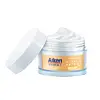What's inside
What's inside
 Key Ingredients
Key Ingredients

 Benefits
Benefits

 Concerns
Concerns

 Ingredients Side-by-side
Ingredients Side-by-side

Water
Skin ConditioningTrehalose
HumectantCyclomethicone
EmollientGlycerin
HumectantStearyl Heptanoate
EmollientOzokerite
Emulsion StabilisingAlpha-Glucan Oligosaccharide
CleansingPseudozyma Epicola/Argania Spinosa Kernel Oil/Olive Fruit Oil/Sunflower Seed Oil/(Angelica Gigas/Licorice/Lithospermum Erythrorhizon) Root Ferment Extract Filtrate
EmollientPropylene Glycol
HumectantIsononyl Isononanoate
EmollientCalamine
AbsorbentDimethicone
EmollientSodium Chloride
MaskingCetyl PEG/PPG-10/1 Dimethicone
EmulsifyingEthoxydiglycol
HumectantPhenoxyethanol
PreservativePolymnia Sonchifolia Root Juice
Skin ConditioningAloe Barbadensis Leaf Extract
EmollientTocopheryl Acetate
AntioxidantPropanediol
SolventMaltodextrin
AbsorbentSorbitan Caprylate
EmulsifyingSodium Hyaluronate
HumectantDimethicone/PEG-10/15 Crosspolymer
Biosaccharide Gum-1
HumectantDimethicone/Vinyl Dimethicone Crosspolymer
Skin ConditioningLactobacillus
Skin ConditioningButylene Glycol
HumectantTriethoxycaprylylsilane
1,2-Hexanediol
Skin ConditioningWater, Trehalose, Cyclomethicone, Glycerin, Stearyl Heptanoate, Ozokerite, Alpha-Glucan Oligosaccharide, Pseudozyma Epicola/Argania Spinosa Kernel Oil/Olive Fruit Oil/Sunflower Seed Oil/(Angelica Gigas/Licorice/Lithospermum Erythrorhizon) Root Ferment Extract Filtrate, Propylene Glycol, Isononyl Isononanoate, Calamine, Dimethicone, Sodium Chloride, Cetyl PEG/PPG-10/1 Dimethicone, Ethoxydiglycol, Phenoxyethanol, Polymnia Sonchifolia Root Juice, Aloe Barbadensis Leaf Extract, Tocopheryl Acetate, Propanediol, Maltodextrin, Sorbitan Caprylate, Sodium Hyaluronate, Dimethicone/PEG-10/15 Crosspolymer, Biosaccharide Gum-1, Dimethicone/Vinyl Dimethicone Crosspolymer, Lactobacillus, Butylene Glycol, Triethoxycaprylylsilane, 1,2-Hexanediol
Water
Skin ConditioningNiacinamide
SmoothingGlycerin
HumectantBetaine
HumectantButylene Glycol
HumectantBiosaccharide Gum-1
HumectantDimethicone
EmollientCyclopentasiloxane
EmollientCarbomer
Emulsion StabilisingCyclohexasiloxane
EmollientBisabolol
MaskingAminomethyl Propanol
BufferingSodium Polyacrylate
AbsorbentXanthan Gum
EmulsifyingDisodium EDTA
Sodium Hyaluronate
HumectantDiethylhexyl Syringylidenemalonate
Skin ProtectingTrideceth-6
EmulsifyingPEG/PPG-18/18 Dimethicone
EmulsifyingMandelic Acid
AntimicrobialMelia Azadirachta Leaf Extract
Skin ConditioningCaprylic/Capric Triglyceride
MaskingPEG-40 Hydrogenated Castor Oil
EmulsifyingPolysorbate 20
EmulsifyingMelaleuca Alternifolia Leaf Oil
AntioxidantSalicylic Acid
MaskingZingiber Officinale Root Extract
MaskingAscorbyl Glucoside
AntioxidantParfum
MaskingPhenoxyethanol
PreservativeChlorphenesin
AntimicrobialWater, Niacinamide, Glycerin, Betaine, Butylene Glycol, Biosaccharide Gum-1, Dimethicone, Cyclopentasiloxane, Carbomer, Cyclohexasiloxane, Bisabolol, Aminomethyl Propanol, Sodium Polyacrylate, Xanthan Gum, Disodium EDTA, Sodium Hyaluronate, Diethylhexyl Syringylidenemalonate, Trideceth-6, PEG/PPG-18/18 Dimethicone, Mandelic Acid, Melia Azadirachta Leaf Extract, Caprylic/Capric Triglyceride, PEG-40 Hydrogenated Castor Oil, Polysorbate 20, Melaleuca Alternifolia Leaf Oil, Salicylic Acid, Zingiber Officinale Root Extract, Ascorbyl Glucoside, Parfum, Phenoxyethanol, Chlorphenesin
Ingredients Explained
These ingredients are found in both products.
Ingredients higher up in an ingredient list are typically present in a larger amount.
Biosaccharide Gum-1 is a sugar created by fermenting sorbitol (which usually comes from potato starch!). It is known for its soothing and moisturizing properties.
Manufacturer tests show this ingredient helped reduce irritation from lactic acid by almost half and kept skin hydrated long-term as a humectant
Beyond hydration, Biosaccharide Gum-1 gives formulas a silky, non-sticky feel.
This ingredient is gentle, versatile, and suitable for all skin types.
Fun fact: Similar sugars can be found naturally in fruits like apples and pears.
Learn more about Biosaccharide Gum-1Butylene Glycol (or BG) is used within cosmetic products for a few different reasons:
Overall, Butylene Glycol is a safe and well-rounded ingredient that works well with other ingredients.
Though this ingredient works well with most skin types, some people with sensitive skin may experience a reaction such as allergic rashes, closed comedones, or itchiness.
Learn more about Butylene GlycolDimethicone is a type of synthetic silicone created from natural materials such as quartz.
What it does:
Dimethicone comes in different viscosities:
Depending on the viscosity, dimethicone has different properties.
Ingredients lists don't always show which type is used, so we recommend reaching out to the brand if you have questions about the viscosity.
This ingredient is unlikely to cause irritation because it does not get absorbed into skin. However, people with silicone allergies should be careful about using this ingredient.
Note: Dimethicone may contribute to pilling. This is because it is not oil or water soluble, so pilling may occur when layered with products. When mixed with heavy oils in a formula, the outcome is also quite greasy.
Learn more about DimethiconeGlycerin is already naturally found in your skin. It helps moisturize and protect your skin.
A study from 2016 found glycerin to be more effective as a humectant than AHAs and hyaluronic acid.
As a humectant, it helps the skin stay hydrated by pulling moisture to your skin. The low molecular weight of glycerin allows it to pull moisture into the deeper layers of your skin.
Hydrated skin improves your skin barrier; Your skin barrier helps protect against irritants and bacteria.
Glycerin has also been found to have antimicrobial and antiviral properties. Due to these properties, glycerin is often used in wound and burn treatments.
In cosmetics, glycerin is usually derived from plants such as soybean or palm. However, it can also be sourced from animals, such as tallow or animal fat.
This ingredient is organic, colorless, odorless, and non-toxic.
Glycerin is the name for this ingredient in American English. British English uses Glycerol/Glycerine.
Learn more about GlycerinPhenoxyethanol is a preservative that has germicide, antimicrobial, and aromatic properties. Studies show that phenoxyethanol can prevent microbial growth. By itself, it has a scent that is similar to that of a rose.
It's often used in formulations along with Caprylyl Glycol to preserve the shelf life of products.
Sodium Hyaluronate is hyaluronic acid's salt form. It is commonly derived from the sodium salt of hyaluronic acid.
Like hyaluronic acid, it is great at holding water and acts as a humectant. This makes it a great skin hydrating ingredient.
Sodium Hyaluronate is naturally occurring in our bodies and is mostly found in eye fluid and joints.
These are some other common types of Hyaluronic Acid:
Learn more about Sodium HyaluronateWater. It's the most common cosmetic ingredient of all. You'll usually see it at the top of ingredient lists, meaning that it makes up the largest part of the product.
So why is it so popular? Water most often acts as a solvent - this means that it helps dissolve other ingredients into the formulation.
You'll also recognize water as that liquid we all need to stay alive. If you see this, drink a glass of water. Stay hydrated!
Learn more about Water